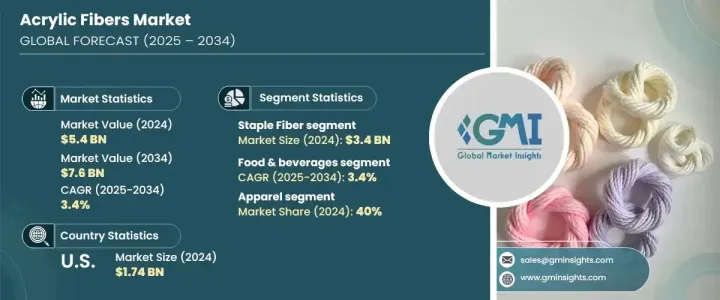PUBLISHER: Global Market Insights Inc. | PRODUCT CODE: 1684767

PUBLISHER: Global Market Insights Inc. | PRODUCT CODE: 1684767
Acrylic Fibers Market Opportunity, Growth Drivers, Industry Trend Analysis, and Forecast 2025 - 2034
The Global Acrylic Fibers Market is expected to reach USD 5.4 billion in 2024 and is projected to grow at a CAGR of 3.4% between 2025 and 2034. Acrylic fibers are widely utilized in the manufacturing of various apparel items, such as sweaters, socks, and sportswear. The market growth is largely driven by the increasing demand for lightweight, durable, and cost-effective materials that cater to evolving consumer preferences for synthetic fabrics and modern fashion trends. Acrylic fibers are particularly favored for their versatility, offering both style and functionality. As fashion trends evolve, these fibers continue to gain traction due to their wide application and benefits, including their resistance to wear and tear and ease of maintenance. The growing inclination toward synthetic materials in the textile industry further boosts the market as consumers look for affordable and sustainable options without compromising on quality.

Segmenting the market by fiber type reveals two major categories: Tow (Tow-Dyed) Fiber and Staple Fiber. In 2024, Staple Fiber took the lead, generating USD 3.4 billion in revenue. Staple fibers are widely used in textiles such as blankets, carpets, and sweaters, showcasing their versatility and cost-effectiveness. These fibers are prized for their softness, durability, and ability to maintain shape over time, making them an ideal choice for both fashion and home textile industries. The popularity of staple fibers is also fueled by seasonal demands and a growing preference for comfortable, low-maintenance fabrics that cater to a variety of consumer needs.
| Market Scope | |
|---|---|
| Start Year | 2024 |
| Forecast Year | 2025-2034 |
| Start Value | $5.4 Billion |
| Forecast Value | $7.6 Billion |
| CAGR | 3.4% |
In terms of end-use, the acrylic fibers market is divided into several key sectors: filtration and separation, textiles, automotive, construction, aerospace and defense, healthcare, and others. Among these, the textile industry holds the largest share. In 2024, the textile segment continued to thrive due to increasing consumer demand for affordable, high-quality clothing. Acrylic fibers' adaptability to various styles and ability to cater to changing fashion trends solidify their position in the global textile market.
In the U.S. alone, the acrylic fibers market generated USD 1.74 billion in 2024. A significant driver of growth within the U.S. market is the rising adoption of acrylic fibers in automotive interiors. With a growing emphasis on aesthetically pleasing and comfortable vehicle designs, manufacturers are turning to acrylic fibers to enhance the interior experience. Emerging trends in interior design and an increasing preference for high-quality materials are expected to propel this segment even further in the coming years.
The acrylic fibers market is set for steady growth, supported by its broad range of applications across diverse industries. As consumers continue to seek lightweight, durable, and easy-to-maintain products, and industries from fashion to automotive keep relying on acrylic fibers, the market's upward trajectory is expected to be sustained through 2034.
Table of Contents
Chapter 1 Methodology & Scope
- 1.1 Market scope & definition
- 1.2 Base estimates & calculations
- 1.3 Forecast calculation
- 1.4 Data sources
- 1.4.1 Primary
- 1.4.2 Secondary
- 1.4.2.1 Paid sources
- 1.4.2.2 Public sources
Chapter 2 Executive Summary
- 2.1 Industry synopsis, 2021-2034
Chapter 3 Industry Insights
- 3.1 Industry ecosystem analysis
- 3.1.1 Factor affecting the value chain
- 3.1.2 Profit margin analysis
- 3.1.3 Disruptions
- 3.1.4 Future outlook
- 3.1.5 Manufacturers
- 3.1.6 Distributors
- 3.2 Supplier landscape
- 3.3 Profit margin analysis
- 3.4 Key news & initiatives
- 3.5 Regulatory landscape
- 3.6 Impact forces
- 3.6.1 Growth drivers
- 3.6.1.1 Growing textile industry
- 3.6.1.2 Growing automotive industry
- 3.6.1.3 Growing construction industry
- 3.6.2 Industry pitfalls & challenges
- 3.6.2.1 Competition from Other Synthetic Fibers
- 3.6.2.2 Fluctuating Raw Material Prices
- 3.6.2.3 Environmental Concerns
- 3.6.1 Growth drivers
- 3.7 Growth potential analysis
- 3.8 Porter’s analysis
- 3.9 PESTEL analysis
Chapter 4 Competitive Landscape, 2024
- 4.1 Introduction
- 4.2 Company market share analysis
- 4.3 Competitive positioning matrix
- 4.4 Strategic outlook matrix
Chapter 5 Market Size and Forecast, By Fiber Type, 2021-2034 (USD Billion) (Kilo Tons)
- 5.1 Key trends
- 5.2 Staple fiber
- 5.3 Tow (Tow-Dyed) fiber
Chapter 6 Market Size and Forecast, By Application, 2021-2034 (USD Billion) (Kilo Tons)
- 6.1 Key trends
- 6.2 Apparel
- 6.3 Home textiles
- 6.4 Nonwoven fabrics
- 6.5 Industrial and technical textiles
- 6.6 Carpets and rugs
- 6.7 Outdoor and recreational products
- 6.8 Upholstery
- 6.9 Blankets and bedding
- 6.10 Craft and hobby
- 6.11 Others
Chapter 7 Market Size and Forecast, By End-Use, 2021-2034 (USD Billion) (Kilo Tons)
- 7.1 Key trends
- 7.2 Textile industry
- 7.3 Automotive industry
- 7.4 Construction industry
- 7.5 Filtration and separation
- 7.6 Aerospace and defense
- 7.7 Healthcare industry
- 7.8 Others
Chapter 8 Market Size and Forecast, By Region, 2021-2034 (USD Billion) (Kilo Tons)
- 8.1 Key trends
- 8.2 North America
- 8.2.1 U.S.
- 8.2.2 Canada
- 8.3 Europe
- 8.3.1 UK
- 8.3.2 Germany
- 8.3.3 France
- 8.3.4 Italy
- 8.3.5 Spain
- 8.3.6 Russia
- 8.4 Asia Pacific
- 8.4.1 China
- 8.4.2 India
- 8.4.3 Japan
- 8.4.4 South Korea
- 8.4.5 Australia
- 8.5 Latin America
- 8.5.1 Brazil
- 8.5.2 Mexico
- 8.6 MEA
- 8.6.1 South Africa
- 8.6.2 Saudi Arabia
- 8.6.3 UAE
Chapter 9 Company Profiles
- 9.1 International Paper
- 9.2 ITC
- 9.3 Mondi
- 9.4 Nippon Paper Industries
- 9.5 Oji Holding Corporation
- 9.6 Smurfit Kappa
- 9.7 South African Pulp & Paper Industries
- 9.8 Stora Enso
- 9.9 Svenska Cellulosa Aktiebolaget




